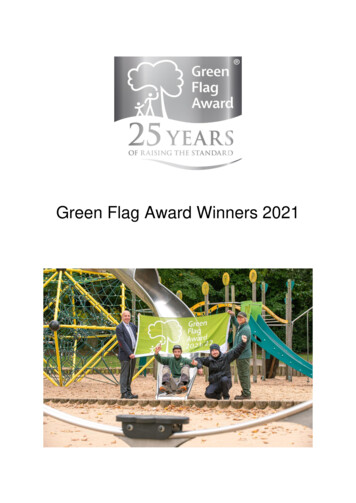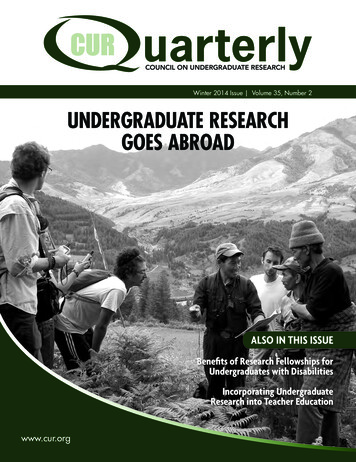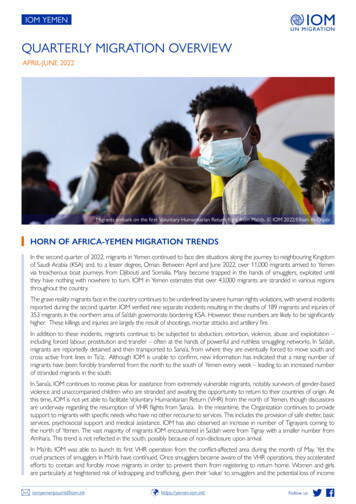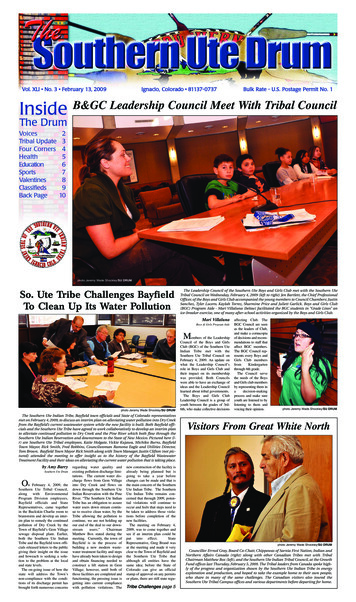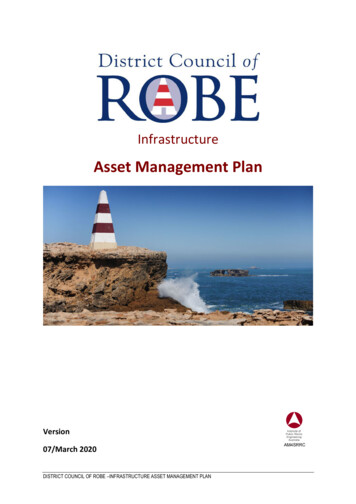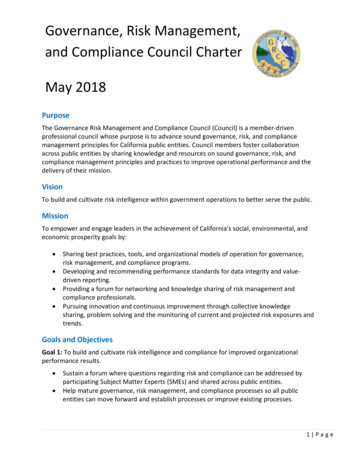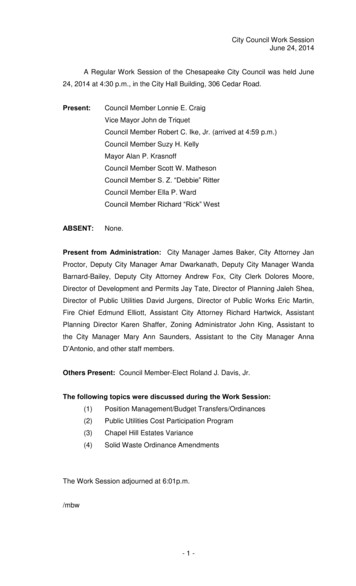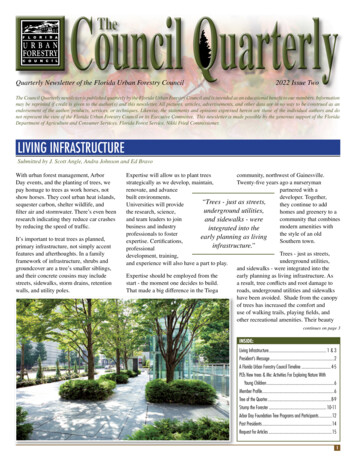
Transcription
Council QuarterlyTheQuarterly Newsletter of the Florida Urban Forestry Council2022 Issue TwoThe Council Quarterly newsletter is published quarterly by the Florida Urban Forestry Council and is intended as an educational benefit to our members. Informationmay be reprinted if credit is given to the author(s) and this newsletter. All pictures, articles, advertisements, and other data are in no way to be construed as anendorsement of the author, products, services, or techniques. Likewise, the statements and opinions expressed herein are those of the individual authors and donot represent the view of the Florida Urban Forestry Council or its Executive Committee. This newsletter is made possible by the generous support of the FloridaDepartment of Agriculture and Consumer Services, Florida Forest Service, Nikki Fried Commissioner.Living InfrastructureSubmitted by J. Scott Angle, Andra Johnson and Ed BravoWith urban forest management, ArborDay events, and the planting of trees, wepay homage to trees as work horses, notshow horses. They cool urban heat islands,sequester carbon, shelter wildlife, andfilter air and stormwater. There’s even beenresearch indicating they reduce car crashesby reducing the speed of traffic.It’s important to treat trees as planned,primary infrastructure, not simply accentfeatures and afterthoughts. In a familyframework of infrastructure, shrubs andgroundcover are a tree’s smaller siblings,and their concrete cousins may includestreets, sidewalks, storm drains, retentionwalls, and utility poles.Expertise will allow us to plant treescommunity, northwest of Gainesville.strategically as we develop, maintain,Twenty-five years ago a nurserymanrenovate, and advancepartnered with abuilt environments.developer. Together,“Trees - just as streets,Universities will providethey continue to addunderground utilities,the research, science,homes and greenery to aand team leaders to joincommunity that combinesand sidewalks - werebusiness and industrymodern amenities withintegrated into theprofessionals to fosterthe style of an oldearly planning as livingexpertise. Certifications,Southern town.infrastructure.”professionalTrees - just as streets,development, training,underground utilities,and experience will also have a part to play.and sidewalks - were integrated into theExpertise should be employed from theearly planning as living infrastructure. Asstart - the moment one decides to build.a result, tree conflicts and root damage toThat made a big difference in the Tiogaroads, underground utilities and sidewalkshave been avoided. Shade from the canopyof trees has increased the comfort anduse of walking trails, playing fields, andother recreational amenities. Their beautycontinues on page 3INSIDE:Living Infrastructure. 1 & 3President’s Message.2A Florida Urban Forestry Council Timeline.4-5PLTs New trees & Me: Activities For Exploring Nature WithYoung Children.6Member Profile.6Tree of the Quarter.8-9Stump the Forester.10-11Arbor Day Foundation Tree Programs and Participants.12Past Presidents.14Request for Articles.151
President’s messageurban forest are living infrastructurethat need to be managed and protected.How can you take action? Educate,educate, educate. Educate children.Educate your friends and family.Educate your community. The FUFC ishere to help you do just that.On behalf of the Executive Committee,I would like to thank you for takingthe time to read this issue of TheCouncil Quarterly newsletter and forbeing an active member of the FloridaUrban Forestry Council (FUFC). YourFUFC membership allows the Councilto continue its mission to promotethe value, enhancement, and soundmanagement of urban forests throughleadership, collaboration, guidance, andeducation.Your membership brings you intoa community of highly skilled anddedicated urban forestry professionalsand advocates across the state ofFlorida. We are a community that ishere to work together. It is our collectivetime, dedication, talent, experience, andfinancial support that allows the Councilto exist and thrive.I often get asked by FUFC members,“What can I do?” or “How can I helpmake a difference?” My responseis to take action. Joe Anderson, ourImmediate Past President, said itbest, “Urban Forestry is not a noun.It is a verb. It is an action word.” Weneed your help to educate our fellowFloridians on the benefits of urban treesand urban forest management.I wholeheartedly agree with thesentiments expressed in this issue’sLiving Infrastructure article. We canno longer allow urban trees to betreated as if they are disposable. Weneed to continue our work to educatestakeholders in the public, private, andgovernmental sectors that trees and the2When educating children, we cannotstart soon enough. The article “PLTsNew Trees & Me: Activities ForExploring Nature With Young Children”is a great resource that can be sharedwith parents of children ages 1-6. Weneed to get tree-related resources inthe hands of our educators, parents,and children. These activities helpto cultivate the love of trees in ouryouth, our future generation. It teacheschildren to see trees as dynamic andliving organisms and helps themdevelop a connection with the naturalworld. Please help us share this content!The FUFC Executive Committee iscurrently developing a webpage onthe Council’s website (https://fufc.org/) dedicated exclusively to youtheducational resources. We recently hada mother of two Boy Scouts write usa Thank You note. The boys found aplethora of good information on ourwebsite and it helped them earn theirForestry badge. We want to continue tomake it easy for children to learn moreabout trees, and what better way to dothat than on our website. A platformthat is available and free to all, 24/7.FUFC provides wonderful tree-relatedresources on our social media platforms.Please join us on Facebook, Instagram,and Twitter. Share the information withyour friends and family. Sharing ourposts is an excellent way to take actionand inform those around you on thevalue of trees and the work that youdo. Trees are important. They are to bevalued and enjoyed.Finally, educating your communityis essential. There are two easy waysyou can share information to help yourcommunity’s forest. (1) Perhaps youare a tree advocate or professional thatis very involved in managing the City’surban forest. Please be sure to viewour webpage dedicated exclusively tomanaging an urban forestry program:https://fufc.org/soap-resources/. Thiswebpage has resources on S.O.A.P. Thisacronym stands for the componentsneeded to manage an urban forest:staff, ordinances, advocacy, and plans.Viewing and sharing these resourcescan influence other urban forestsstakeholders and may build support forthe management of your community’strees and forests. (2) This issue has anarticle on the Arbor Day Foundationprograms that can assist communitieswith becoming Tree City USA orperhaps help schools with becominga Tree Campus K-12. Learn moreabout these programs and share thisinformation with your local city orschool.How you chose to be active and howyou chose to educate is limitless, but Ican guarantee every bit of informationand inspiration that you share makesa difference. I often think of it as aripple that continues far beyond ourcomprehension but is felt by many.Education is so crucial to our mission.With your help, we can grow a bettertomorrow for our State’s urban forest.As always, thank you for being amember of the Florida Urban ForestryCouncil. We need and appreciate you!Gratefully,Erin GivensFUFC President
continued from page 1has attracted visitors and an economy toTioga. The nurseryman’s familiarity withtree stock, soil requirements, and climateconditions guided the selection of trees thatwould live and remain healthy for threequarters of a century.We shouldn’t take that for granted. Someresearch estimates the average lifespan ofan urban tree to be as little as 13 years.A USDA study says we’re losing tens ofmillions of city trees from development,fire, hurricanes, insects, and disease—andtens of millions of dollars in the payoffs thathealthy urban forests could deliver.Treating urban trees as if they are disposableneeds to stop. It’s a challenge to enlightenboth professionals and homeowners aboutthe proper care and management of trees,forests, and living infrastructure. In Floridawe need more city arborists. We need betterunderstanding of how trees function andtheir site requirements. We need to knowmore about which trees are most resilient tohurricanes so we can avoid injury to peopleand damage to property. We need to investin the health of our living infrastructure.All this will require science, research, andengaged students and faculty.The University of Florida Institute of Foodand Agricultural Sciences (UF/IFAS)School of Forest, Fisheries, and GeomaticsSciences (SFFGS) is adding facultymembers with the capability of employingartificial intelligence to the study of urbantrees. For example, advanced technologyof AI-equipped drones allow us to countcitrus trees with 98 percent accuracy. Thinkof how this could help monitor urban treeinventories.The new UF/IFAS Dean of Extension—theuniversity’s leader of statewide outreachof university-based science to 22 millionFloridians - has three degrees in urbanforestry. Florida has Extension agents activein urban forestry in Jacksonville, Tampa,Gainesville, and other cities. Together, UF/IFAS and SFFGS, are preparing the nextgeneration of natural resource professionalsto help manage Florida’s future forests.organizations are getting involved andweighing in on public policy regardingtrees and urban forests. Landscapearchitects, nurserymen, and other tree-careprofessionals have established relationshipswith urban planners that make it more likelythat the right trees will be planted in theright places, at the right times.This nation is about to invest more than atrillion dollars in its roads, bridges, ports,and tunnels. When moving Florida forward,let’s not forget that trees are an essentialelement of our infrastructure.J. Scott Angle is the University of Florida’sSenior Vice President for Agriculture andNatural Resources and leader of the UFInstitute of Food and Agricultural Sciences(UF/IFAS).Andra Johnson is the UF/IFAS Dean ofExtension and Director of the FloridaCooperative Extension Service. He hasBachelor’s and Master’s degrees and aPh.D. in urban forestry.Ed Bravo is a past president of theFlorida Nursery, Growers and LandscapeAssociation, general manager and partnerof Big Trees Plantation in Newberry, whichdesigned, developed and maintains thelandscaping for the Town of Tioga.In private industry, the Florida Nursery,Growers and Landscape Association(FNGLA), and other professional3
A Florida Urban Forestry Council TimelineSubmitted by the FUFC Communication CommitteeA very brief synopsis about the Florida Urban Forestry Council (FUFC) is providedunder the “ABOUT US” tab on the fufc.org website (https://fufc.org/history). It opensthe story in 1990 with a vision and basic blueprint for the stakeholders, caregivers, andstewards of urban forestry. The early framework was adopted on April 10, 1991, as theFUFC was incorporated to act on behalf of urban forest, urban forest management, andurban forest issues in the state of Florida.Actually, the story of a statewideapproach to urban forest managementstarted nearly 20 years earlier. In1970, the U.S. Forest Service selectedFlorida – and two other states – topilot an urban forestry technicalassistance program. In 1971, atree-minded Florida Legislatureamended the State’s existing CountyForester Law (F.S. 589.28) making itpossible for County Commissionersand municipalities to enter into legalcontracts with the Florida Departmentof Agriculture and Consumer Services(FDACS) through the Department ofForestry (DOF) – referred to today asthe Florida Forest Service (FFS). Ineffect, Federal urban and communityforestry programs and resources wouldbe channeled through the state’s ForestService. Urban forestry resources,initiatives, and communities tookroot and began to sprout. Municipaland utility arboriculture was put intopractice with professional forestersand arborists on staff; private tree careprofessionals and consulting agencieswere sponsoring solutions; treeprotection ordinances were drawn; treeadvocacy groups were formed; andurban forestry plans were developed.The business of urban forestry wasunderway with staffing, ordinances,advocacy, and planning (S.O.A.P.)principles.197041972By 1972 urban forestry programswere initiated in Metropolitan DadeCounty, Fort Lauderdale, Jacksonville,and Hollywood, Florida. By 1974, thenumbers grew to thirteen additionalurban-oriented forestry projects.In 1989, the DOF hosted the firstannual Urban and CommunityForestry Conference, at St.Augustine, FL. Following itscreation, subsequent annualconferences were administered by thetalent and expertise of the FUFC.By 1995, the capacity of the FFS toprovide staffing for urban forestryprograms was reduced. Urban forestryassistance through the FFS would nowfall on a network of county foresters.Local municipalities, private industry,and tree advocacy groups wouldtake on a larger role and ownershipof urban forestry programs andinitiatives. Technical and financialsupport for the FUFC would continue.FUFC entered a legal contract withthe FFS with its first Strategic Plan.The Strategic Plan was reviewedat ten public meetings throughoutFlorida, including Pensacola, Tampa,Tallahassee, Fort Myers, Jacksonville,Bradenton, Gainesville, North Miami,Orlando, and Fort Lauderdale. TheStrategic Plan is reviewed and revisedevery five years. The 5-year StrategicPlan is accomplished by the goals,objectives, and action items identifiedin 5 consecutive annual work plans.By 1990, the groundwork was setfor FUFC to enter the stage witha script that included the vision,mission, players, and bylaws for itsfounding organization.In 1992, a FUFC awards program wasestablished to recognize outstandingprofessionals, individuals, advocacygroups, projects, and programs inurban forestry. In 2009 the awardsprogram transformed into, the“Friends of Our Urban Forests”awards program.19741989 1990 1991 19921995
Since 1997, through the financialassistance of FFS Urban andCommunity Forestry grants, the FUFCwas able to develop “Trees Love Care”flyers; Right Tree/Right Place posters;educational workshops; and Trees 4Florida public service announcements;and hire a part-time Executive Director.The Executive Director positionbecame full-time in 2003.By 2009, the FUFC began productionof The Council Quarterly newsletter.Production of a full-color newsletterand digital distribution began in 2010.In 2012, the FUFC held its firstannual Urban Forestry Institute(UFI) conference, in Orlando, FL.At this first UFI event, S.O.A.P. wasintroduced as an acronym for Staffing,Ordinance, Advocacy, and Planning– four key components for successfulurban forestry management. In 2021,the FUFC launched its first UFI in avirtual format.In 2000, FUFC began an eight-yearpartnership with Florida Chapter of theInternational Society of Arboriculture(ISA) to co-host an annual TreesFlorida Conference.In 2013, Tree of the Quarter andStump The Forester became permanentfixtures inside the pages of TheCouncil Quarterly newsletter.In 2001 the FUFC website www.FUFC.org was launched.By 2015, the FUFC joined the digitalage. The e-bulletin In-A-Nutshellwas up and running providing timely,urban forestry-related information andupdates about what was happeningaround the state. The FUFC alsolaunched its first social media sitesincluding Facebook, Twitter, andInstagram.Trail of Trees youth programs weresponsored throughout Florida schoolsby 2004.By 2008, with proceeds from theTrees Florida Conferences, andco-sponsorship from ISA-Florida,the John P. White MemorialScholarship was established tosupport students pursuing careers inFlorida’s arboriculture industry, orrelated field. Financial assistance wasprovided for undergraduate, graduate,or other advanced educationprograms.19972000 20012003 2004Graphic elements provided by VecteezyFlorida Urban Forestry Council Timeline, continued from page 4.2008 2009 2010Through the years, the FUFC hascontinued to increase its structuralcanopy and dripline. The benefits willcontinue to mature as the organizationmatures and grows. The FUFC wouldlike to extend a heartfelt “thank you”to all those that have helped, that arehelping, and will long into the future,help the FUFC promote the value,enhancement, and sound managementof urban forests through leadership,collaboration, guidance, and education.2012 201320152021 20225
PLTs New trees & Me: Activities For Exploring Nature WithYoung ChildrenSubmitted by the FUFC Communication CommitteeProject Learning Tree’s Tree & Me: Activities for Exploring Nature with Young Childrencombines the fascination that children ages 1-6 have for trees with research-based findingsabout the lifelong benefits of early exposure to nature. Through hands-on experiencesorganized around 12 topics, children are engaged and learning, both indoors and outdoors.Families and caregivers, childcare providers, and early childhood educators can easily adaptTrees & Me to meet each child’s unique needs, the different environments where they live,and the materials available.Trees & Me and Urban ForestsIntroducing young children especially in urban areas to trees is critical. When weshare trees and nature with young children, we can help them develop an awarenessand appreciation for their natural world. Connecting kids to nature and the outdoorsimproves their emotional and physical well-being, enhances learning, promotes positivesocial behavior, and makes them more likely to care about their environment. Creatingopportunities to interact with young children, (preschool, events, festivals, etc.) and usingactivities from the Trees & Me guide is an easy tool to help you connect young childrenwith nature in their urban world.Member ProfileHow long have you been involved withurban forestry?I’ve been involved with urban forestry since1993 while I was in college at WesternIllinois University, an ISA certified Arboristin 1996, and Board-Certified MasterArborist (BCMA) since 2005. I was one ofthe very first individuals to pass the BCMAExam.What is the most rewarding part of your urbanforestry career?What is your Name?John SnowWhat is your organization or business?My company is Tree Check Up, an onlinecommunity for serious arborists. I alsoconsult for homeowners associations,private residential properties, and commercial properties, focusing on developingmanagement plans, tree assessments,Tree Risk Assessments (TRAQ), and treepreservation plans.What is your role/title?I am the owner and Community ExperienceDirector for Tree Check Up and a partner inPlatinum Tree Management.6The most rewarding part of my career isworking with people who are passionateabout caring for and conserving trees andnatural environments. As part of the onlinecommunity, my goal and passion are to helpother Arborists learn more about our urbanforests and trees in general and help developthe next generation of Arborists andUrban Foresters.Why did you join the FUFC?When I was looking to relocate to Florida,one of the first things I did was explorethe different organizations throughout thestate. That’s how I learned about the FloridaUrban Forestry Council. I looked at theFUFC mission and resources and thoughtthis is a great organization that would helpfurther my consulting practice. I joined andattended my first Urban Forestry Institute(UFI) two years ago and have been involvedsince. I never imagined that I wouldvolunteer to serve on a committee, but I’mglad I did. It allows me to be part of shapingthe future of our industry and allows me tonetwork with other professionals who maynot necessarily be Arborists. I believe thatthe management of urban forests requires adiverse, multidisciplinary approach which isexactly what FUFC offers.Is there anything you would like to promote aboutyourself or your business to the FUFC membership?I’d be interested in connecting with anyonewho needs a leading Tree Care authority onHomeowners Associations or those interested in Tree Preservation projects. Also, Iwould like to extend the opportunity to joinTree Check Up Pro to anyone serious aboutArboriculture and the management of urbanforests. The online community is a place tolearn, earn CEU’s, grow your career, andnetwork with other professionals throughoutthe US and Canada. It is not restricted toonly being an ISA Certified Arborists butrather anyone that is a serious Arborist orUrban Forester. If either of these interestyou, email me a JohnSnow@TreeCheckUp.com.Is there anything else you would like to add (i.e.favorite activities, kids, dogs, etc.)?Of course, I enjoy looking at trees. I do a lotof reading and enjoy the occasional movie. Ialso have six children and three cats.
7
Tree QuarteroftheSouthern Magnolia(Magnolia grandiflora)Submitted by Joe Anderson – ISA Arborist andUtility Forester for JEAhardiness zones 7-9. It grows in severalFlorida’s ecological areas – typically shady,well-drained soils, and exhibits relativelyslow growth. The tree can tolerate partialshade, but the densest form and floweringoccurs in full sun. Once established S.magnolia is the most drought-resistant ofother magnolias.Form:Few tree species can rival Magnoliagrandiflora for its stunning display ofgrandeur, majesty, and distinction –especially when mature and in bloom.Native to the southeastern U.S., andemblematic of the American South, thestately aristocrat is commonly known as theSouthern magnolia - the most well-knownmagnolia in Florida. As an ornamental themagnolia can be an outstanding landmark inany landscape, with large, glossy, evergreenleaves and lovely white blossoms. Thespecific epithet is derived from the Latinwords grandis “big” and flor “flower.”The name magnolia is derived from theFrench botanist Pierre Magnol (16381715) – director of the botanical gardenat Montpellier, France. Once established,the Southern magnolia requires lowmaintenance regarding survival, but somemay consider the litter of large, leatheryleaves and seed pods a nuisance.Habitat/Environment:Southern magnolia can be found in mixedstands along coastal bottomlands. It adaptswell in fertile, sandy, well drained, acidicsoils. It grows naturally from Virginia southto central Florida, and west to eastern Texas;8Attractive upright and slightly spreadingcanopy; having a growth potential of 80ft. tall with a canopy spread of 40 ft. wide.Typically forms a tall, straight bole andsomewhat pyramidal crown. To avoid utilityconflicts, the recommended setback fromoverhead power lines is 50 ft. The maturemagnolia lends itself well for directionalpruning when mitigating conflicts withurban infrastructure; and slow growthlends itself well for routine cyclic pruningschedules for utilities or right-of-waycorridors.Leaves:Large, simple, thick, glossy/lustrous, darkgreen, oval-shaped leaves are persistent,forming a dense, evergreen canopy. Leavesare long and leathery – 6”-10” long; andhaving wooly undersides varying from palegreen to rusty color. The top waxy surfaceof the leaves creates a shiny appearance andsome tolerance for salt spray and pollution.Bark:Smooth to slightly scaly texture, commonlylight grey in color.Roots:Relatively shallow roots. The wide-rangedroot system can expand 4 times thecanopy width. Large, flexible, aromatic,rope-like roots tend to grow horizontally,not vertically, and close to the soil surface.The roots can cause uplift and damage toadjacent concrete surfaces if planted tooclose to walkways and driveways. Rootswill seek water.
Flowers:Fruits:Exceptional blossoms – large and showy.Commonly 6”-8” across. Powerfullyfragrant. Flowers can possess 6-12 petals.Most often white, but depending on thespecies flowers can be cream, pinkish, oryellowish in color. Flowers do not producetrue nectar, but they do produce sugarysecretions and large quantities of pollen.Dark brown pods/cones 3”-4” long, withvelvety surface, and bright red seeds in thefall. The seeds are not edible and mildlypoisonous for humans, but are a good foodsource for birds, small mammals, and otherwildlife.Uses or Usefulness:The Southern magnolia is an outstandingornamental as a center piece in a landscapeor collectively grown to form effective windblocks, and sight and/or sound barriers.Magnolia wood is ranked moderate inheaviness, stiffness, low shrinkage, bending,and compression strength. The wood is usedfor timber, cabinets, veneers, and crates.Little known facts: A verage life span 80 years; maximum lifespan 120 years. According to the Smithsonian, fossilsreveal that magnolias have been aroundsince the Cretaceous period. While therewere dinosaurs at that time, bees stilldid not exist. Magnolias evolved to bepollinated by ancient beetles. State tree of Mississippi.9
STUMP THE FORESTERQUESTION: How do trees help mitigate stormwater, or flooding issues?ANSWER: In a single word, “naturally.” Treesand forest systems help mitigate stormwater and flooding issues naturally. Treesare evolutionarily designed to survive andthrive as living pumps. The vascular androot systems are living pipes. Throughthe process of transpirational pull, wateris absorbed by osmosis from soils at theroots and released as vapor back into theair at the leaf. The vascular tissues (xylem& phloem) connecting roots and leavesoperate as cellular pipes that providea continuous column of water throughthe trunk, branches, and twigs. Waterescaping through the leaves pulls waterup through the water column with theforces of adhesion, cohesion, and pressuregradients. The movement of water in thexylem, and photosynthates in the phloem,are examples of longitudinal, or axialtransport. Simply put, trees are designed topump water. There is no better mechanismmade by man or created by nature moreeffective than trees at pulling availablewater from the capillary space in saturatedsoil. Did you know that a mature shade tree,on a hot summer day, can release 30-40gallons of water a day through the naturalprocess of transpiration? The amount ofwater released will depend on the treespecies, canopy size, site conditions, andweather. However, severe, or prolongedflooding can deplete the soil of free oxygenneeded for aerobic respiration. If saturatedconditions persist for long periods of timeroots will die and the natural pump willcease to operate.Trees and forests are effective, practical,and desirable tools when managingstormwater runoff. This is especiallyimportant in urban, suburban, and land-useareas where natural systems, prior todevelopment, have been disrupted oraltered.Trees are important components of effectivegreen stormwater infrastructure – ifplanned, installed, and maintained properly.Within city rights-of-ways trees – tall,natural, long-lived, arbor-pumps – willshare space with other utilities. Shapingand maintaining the tree will be necessaryContinues on page 11.Working in Harmony with NatureSumter Electric Cooperative has always placed ahigh priority on the environment by working to stayin harmony with nature. Evidence of SECO’s environmentalstewardship is displayed through the following programs.Sumter Electric Cooperative: was named a Tree Line USA utility for the fourth consecutive yearby The National Arbor Day Foundation. Employee arboriculturetraining, public education, and maintaining abundant, healthy trees inSECO’s service area are common practices. installs osprey nesting dishes atop of the utility pole cross arms asneeded for these magnificent birds. places squirrel guards atop the transformers to protect a variety ofanimals from danger, particularly squirrels. offers net metering to members interested in renewable generation suchas photovoltaic systems. recycles retired power equipment, scrap steel, aluminum, copper,porcelain, fluorescent lights, ink printer and copier cartridges, plusmuch more. researches and writes Nature’s Reflections,a special column in the members’ newsletterdeveloped to educate the community on theflora and fauna of Florida with eco-friendlytopics like xeriscaping and conservation.TMOur TeamL E G AC Y A R B O R I S T S E RV I C E SA divisio n of NRPS focused on PRO VID ING INNO VAT IVE SO LUT IONSFOR managing the urban Forest.John Holzaepfel, CA, TRAQ(352)238-0917EriC hoyeR, Ca, rca, TRAQ(863)670-0734Charlie Marcus, Ca, TRAQ(850)570-5963STAN ROSENTHAL, TRAQ(850)508-6771dƌĞĞ /ŶǀĞŶƚŽƌŝĞƐ ĂŶĚ DĂŶĂŐĞŵĞŶƚ WůĂŶƐ dƌĞĞ WƌŽƚĞĐƚŝŽŶ ƚƌĂƚĞŐŝĞƐ dƌĞĞ ƉƉƌĂŝƐĂůƐ ĂŶĚ ZŝƐŬ ƐƐĞƐƐŵĞŶƚ dƌĞĞ KƌĚŝŶĂŶĐĞ ŶĂůLJƐŝƐ dƌĞĞ ,ĞĂůƚŚ ĂƌĞ dƌĞĂƚŵĞŶƚƐ džƉĞƌƚ tŝƚŶĞƐƐ dĞƐƚŝŵŽŶLJ ĚƵĐĂƚŝŽŶĂů tŽƌŬƐŚŽƉƐ Jay Vogel, CA(352)238-0458ŝͲdƌĞĞͬ ŶǀŝƌŽŶŵĞŶƚĂů ŶĂůLJƐŝƐ Creating A Legacy, Growing Your Future Since 1974www.NRPSforesters.com10
Stump the Forester, continued from page 10.for an arbor-pump to safely operate nearoverhead electric lines. As wood, treesare not a good conductor of electricity,but the live vascular system can be a greatconductor. The column of water withinthe vascular tissue has conductive materialwithin the sap – iron, potassium, water,salts, carbon, and other minerals. Even theair space along the surface of a tree canprovide an electrical path to ground.Increasing canopy cover alone may notsubstantially decrease the problemsassociated with stormwater and flooding.However, when trees are installed withpermeable soil design
Institute of Food and Agricultural Sciences (UF/IFAS). Andra Johnson is the UF/IFAS Dean of Extension and Director of the Florida Cooperative Extension Service. He has Bachelor's and Master's degrees and a Ph.D. in urban forestry. Ed Bravo is a past president of the Florida Nursery, Growers and Landscape Association, general manager and partner



